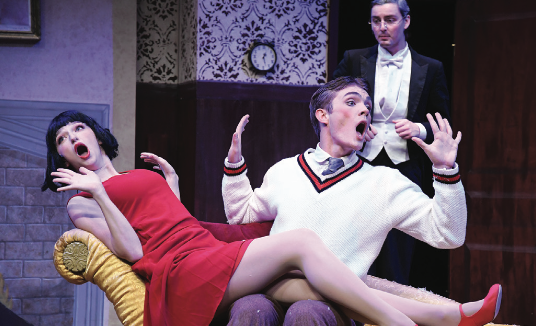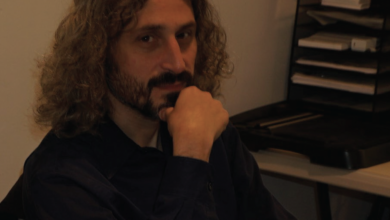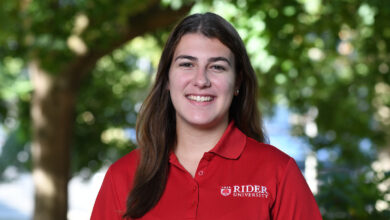
‘The One Act Play That Goes Wrong’ stays true to its home
By Zachary Klein
There are many ingredients that go into making a theatrical production: the script, music, sets, lighting, sound and more. One ingredient that is not often seen is blue painter’s tape, but it’s used in a pre-show scene during “The One-Act Play That Goes Wrong,” which opened on Oct. 28 at the Yvonne Theater. The play started with painter’s tape failing to hold up a mantle is used to help tape as it fails to stick. Stage manager Annie, played by senior acting major Alexa Goyden, calls upon a plant in the audience, junior technical theater and acting major Sean McDonald, to help her put up the mantle. They ultimately fail, and so begins a night filled with failures by the acting company putting on a version of a play called “The Murder of Haversham Manor.”
The cast of Rider’s version included senior musical theater major Kaedon Knight as Thomas Colleymore, whose sister Florence, played by junior musical theater major Ellie Pearlman, visited the setting of Haversham Manor to get married. But when her fiancè Charles Haversham, played by senior musical theater major Joe Love, is killed at the beginning of the show, it opens up a whodunnit mystery. The remainder of the show explores which person inside the house killed Charles and later his brother Cecil, played by junior musical theater major Maclain Rhine.
But the plot of the show is really two-fold. Performing this play are the Cornley University acting company, a low-budget college group who had to cut characters from shows in the past due to lack of funds. Characters are actually two people, with each part consisting of the actor as well as the character they play. For example, Cornley University Director Chris Bean, played by junior acting major Juliette Nero Eddings, also plays Inspector Carter, the antagonist of the play. It becomes confusing at times regarding what is part of the play and what is part of the bad acting, as original authors Henry Lewis, Jonathan Sayer and Henry Shields did not do the best job of distinguishing the humor.
Some of the mishaps this acting company faces during the show include falling objects, collapsing walls, fighting between actors, repeating lines in a circle and a lack of set pieces.
These factors contribute to the comedy of the show, and the audience seemed to love the set dismanteling before their very eyes. Although the show was the most unconventional piece of theater I have ever seen, I thought the actors did a great job composing themselves and not breaking character; moreover, I did not understand what made this show so humorous. It’s not an acting problem, it’s a script problem, as the original play presents many bits of English slapstick humor that isn’t understood by an American audience. Rider’s performance of “The One-Act Play That Goes Wrong” was helmed by Associate Professor Miriam Mills, a seasoned director who has many years of relevant experience. Her choices throughout were well-executed, but unfortunately, sometimes a poorly written play cannot save even the best-directed show.
Despite its short length, the actors take full advantage of the time they have. Every actor in this cast was especially talented and used their comedic voices to communicate the script effectively; however, if I had to choose a standout in this cast, Rhine’s performance as Cecil was exceptional. He was able to use his flexibility and long limbs to toss a telephone back and forth to Knight while still hanging onto objects that had just fallen off the walls. This seemed very difficult to accomplish, but Rhine was able to use his agile hands, knees and feet to get it done. Typically presented in two-act form, “The Play That Goes Wrong” disbuted in London in 2014 and won the Olivier Award for Best New Comedy. It transferred to Broadway in 2017 and opened to very negative reviews from critics, especially The New York Times’ Ben Brantley, who used damaging adjectives throughout his piece. It ended up winning one Tony Award for scenic design of a play and it closed in early January 2019. Professional productions of the two-act version are still playing around the world, including in New York and London, but the one-act version is available to high schools and colleges looking to produce a shorter version.
At just 65 minutes, “The One-Act Play That Goes Wrong,” is just about half of its full counterpart that version is two hours with an intermission. However, the play still felt like a complete piece, with a beginning, middle and very abrupt ending. I thought it was the perfect length, and I do not know what direction the playwrights would have taken for an additional hour. Despite its short length, the actors on stage took full advantage of the time they had.
Although the show was great, I feel the Rider-produced basic scenic design curated by Yoshinori Tanokura could have been taken to a higher level. The show itself is known for its elaborate set, with some productions even equipped with a second floor and an elevator.
While that is not possible on a college campus, the room seemed very bland with paintings of objects instead of actual portraits, which could have added some character to a show with plenty of quirks.
Overall, “The One-Act Play That Goes Wrong,” was a very different type of theatergoing experience. It’s not for everyone, and by reading this you probably know if this show is for you or not. If it is for you and you missed Rider’s production, catch it off Broadway at New World Stages, and see for yourself what could possibly go wrong.



